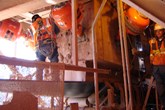Satellite-based risk assessments for mining infrastructure management
Published by Will Owen,
Editor
Global Mining Review,
Reijo Pold, Founder of Value.Space, discusses how satellite-based risk assessments can support the better monitoring of ageing mining infrastructure to support early detection of structural risks and prevent catastrophic failures.
Tailings storage facility (TSF) failures will continue to occur, it’s simply a matter of when and where, not if, unfortunately. Ageing infrastructure and the impacts of climate change are exacerbating already compounding pressures. However, satellite-based movement audits of tailings storage facilities can help the industry to get ahead by identifying, understanding, and monitoring risks in almost real-time.
TSFs – many of them already old – receive more and more tailings as the world transitions to lower carbon energy generation. Compounding the risks posed by ageing are changing climate patterns that were likely not in TSF design calculations 20 – 30 years ago.
The scale of the problem should not be understated – there are currently between 29 000 – 35 000 TSFs worldwide, and World Mine Tailings Failures predicts 13 catastrophic TSF failures occurring between 2025 – 2029. The cost of these failures will be approximately US$2.5 billion per catastrophe (US$32.5 billion total) inclusive of public liabilities, stranded debt, lost stock value, court-ordered payments, and other adjudicated third-party losses.
Given this, the way for the industry to maintain resilient operations in the years ahead is clear – significantly ramp-up the monitoring of TSFs. This was, for instance, the conclusion by local regulators after the recent TSF failure at Surigao del Norte in the Philippines, who urged for improvements in monitoring, regulation, and oversight in the mining industry to de-risk operations and prevent more failures before they occur. However, the world does not have enough engineers to monitor these assets as frequently as satellites.
Satellite-based risk assessments are a cost-effective and fast to deploy solution for improving the monitoring of these critical infrastructure assets. The underlying technology was developed more than 30 years ago, but high costs meant that relatively few could afford to carry out these kinds of assessments.
Now, however, not only have prices come down, but functionality has improved by leaps, meaning the technology has much more to offer stakeholders, risk engineers, and insurers. The cost of investing in this technology is now far lower than the losses incurred should a failure happen, making it an obvious choice for the mining industry.
The key to better monitoring via satellite surveys is in their ability to measure millimetre-scale movements on TSFs as often as every two weeks, giving engineers an almost real-time overview of assets. Once data collected is tracked against historical timelines dating back up to 10 years, and cross-referenced against other useful datasets on weather, geology, and more, the reports produced support the early detection of material deformations that indicate existing or developing structural risks.
These assessments can be conducted globally, continuously and for thousands of sites at the same time, allowing engineers to pinpoint areas that need further investigation. It also frees up engineers to focus attention and resources where it matters most, saving time and capital whilst ensuring the facility’s continuous performance. These benefits are there for the taking, and we expect to see the mining industry evolve to use satellite-based monitoring as standard practice in the near future.
Read the article online at: https://www.globalminingreview.com/mining/30052024/satellite-based-risk-assessments-for-mining-infrastructure-management/
You might also like
Martin Engineering’s new Australian Managing Director shares industry insights
Martin Engineering has hired Darren Gilbert as Managing Director of its Australian Business unit and released a Q&A in which he shares some of his industry insights and experience.


